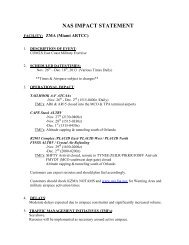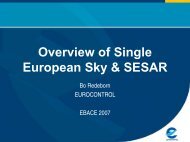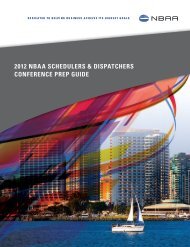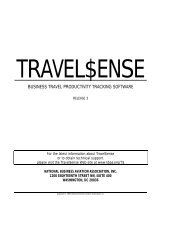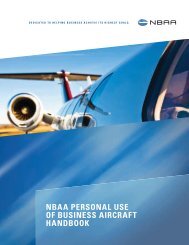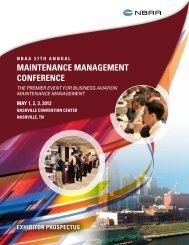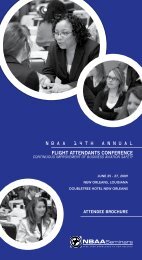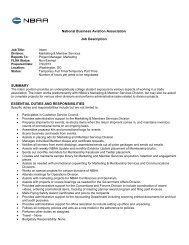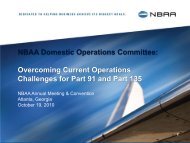2006 NBAA Annual Report
2006 NBAA Annual Report
2006 NBAA Annual Report
Create successful ePaper yourself
Turn your PDF publications into a flip-book with our unique Google optimized e-Paper software.
<strong>2006</strong> <strong>NBAA</strong> ANNUAL REPORT CONTENTSCHAIRMAN’S MESSAGE 2YEAR IN REVIEW 4Advocating for the Industry in the Federal Policy Arena 4Remaining Committed to Supporting <strong>NBAA</strong> Members Locally 6Continuing Our Emphasis on Safety 8Supporting Business Aviation With World-Class Industry Events 10INDEPENDENT AUDITOR’S REPORT AND FINANCIAL STATEMENTS 12Independent Auditor’s <strong>Report</strong> 12Consolidated Statements of Financial Position 13Consolidated Statements of Activities 14Consolidated Statements of Cash Flows 15Notes to Consolidated Financial Statements 16<strong>NBAA</strong> BOARD OF DIRECTORS 20<strong>NBAA</strong> STAFFInside Back Cover
CHAIRMAN’S MESSAGEDear <strong>NBAA</strong> Member CompanyRepresentative:The <strong>2006</strong> <strong>NBAA</strong> <strong>Annual</strong> <strong>Report</strong> reviews theactivities of the Association during the past12 months. This letter highlights some of themost important developments that have takenplace at <strong>NBAA</strong>, and how those actionsstrengthen the Association’s efforts to serve you, its Members.During the past year, your Association has devoted its efforts to thetwin challenges of championing the interests of the industry in thefederal policy arena while providing Member Companies with the best,most up-to-date operational and technical support so that you cancontinue to fly safely, securely and efficiently.AdvocacyIn <strong>2006</strong>, <strong>NBAA</strong>’s primary advocacy challenge has been to counterproposals to dramatically restructure funding and governance of thenational air transportation system. Specifically, the Federal AviationAdministration (FAA) reauthorization process, which is scheduled toconclude in late 2007, is being viewed by some as an opportunity tooverhaul the way the FAA is funded and who makes decisions aboutthe aviation system.The Air Transport Association (ATA), the lobbying group for theairlines, has a proposal that would transfer $2 billion of their costs ontogeneral aviation through the imposition of user fees on GA. The plan,designed to let airlines pay less to use the aviation system while exertingmore control over it, would be calamitous to general aviation, especiallycompanies that rely on business aviation to help them succeed.<strong>NBAA</strong> has forcefully opposed the airlines’ plan from the outset. Shortlyafter the ATA introduced its proposal, <strong>NBAA</strong> President and CEO Ed Bolensent a letter urging <strong>NBAA</strong> Members to use <strong>NBAA</strong>’s online ContactCongress resource to make federal legislators aware of the industry’sstrong, unified opposition to the plan and interest in retaining the currentefficient system under which business aviation pays its fair share of aviationsystem costs through fuel taxes. Independently and with other generalaviation associations, <strong>NBAA</strong> has continued to keep awareness of theissue high through the media and industry forums. In the coming months,<strong>NBAA</strong> will continue to remind elected officials of the industry’s oppositionto any user fee plan.<strong>NBAA</strong> also has been active in its advocacy efforts withfederal regulators. A 2005 accident involving complexaircraft owner and charter arrangements resulted inincreased scrutiny and possible new regulation from the FAA.<strong>NBAA</strong> co-hosted a series of operational control workshopsacross the U.S. to voice concerns from the industry withagency officials; FAA officials took the concerns into accountand made significant changes to their initial policy planning.Safety and OperationsNo less important are the Association’s efforts to promote safety and tohelp its Members deal with the operational challenges they face eachday. Business aviation safety is the industry’s highest priority, and <strong>NBAA</strong>is dedicated to maintaining the community’s strong safety record.In <strong>2006</strong>, <strong>NBAA</strong> continued its long-standing efforts to produce anddisseminate information about safety best practices. The Associationalso built upon its successes in bringing all segments of the industrytogether at events focused on safety.For example, the annual Corporate Aviation Safety Seminar (CASS)had its best turnout ever in <strong>2006</strong>, with more than 400 people in attendance.The event, which has been jointly hosted by <strong>NBAA</strong> and FlightSafety Foundation since 1998, is considered a leading venue for businessaircraft operators to discuss and exchange safety information.To further enhance the safety focus of the Association, <strong>NBAA</strong> addeda second safety-themed event in <strong>2006</strong>. The Association partnered withBombardier Aerospace and the FAA to produce the Safety Standdown,an annual event that seeks to improve business aviation safety byfocusing on human factors.In <strong>2006</strong>, <strong>NBAA</strong> developedseveral newMember benefits thatenhance safety and efficiency.The Forum forEnhanced Reliability andMaintainabilityStandards (FERMS) is anInternet-based tool thatprovides manufacturersand operators, through acentral information clearinghouse,with real-time information about business aircraft maintenanceand performance. Another web-based product is the National AirspaceSystem Status Briefing (NASSB), a user-friendly resource that provides aninstant snapshot of domestic ATC traffic management initiatives andrestrictions (shown).<strong>NBAA</strong> also introduced a new newsletter, titled <strong>NBAA</strong> Navigator,which is produced by <strong>NBAA</strong>’s GA Desk and designed to alert Memberflight departments about important air traffic controlchanges and other national airspace operational challengesin a concise and easy-to-reference format. Membershave responded very positively to this valuable and userfriendlyprinted resource.In addition, <strong>NBAA</strong> updated and strengthened theAssociation’s Management Guide and Airports Handbook(coming by year’s end), each of which contains extensiveinformation on business aviation safety. The Association2 <strong>2006</strong> <strong>NBAA</strong> ANNUAL REPORT
has continued to provide <strong>NBAA</strong>’s Journal of Business Aviation Safetyto all Members at no cost.As part of its continuing commitment to support Members’ operationsat the local level, <strong>NBAA</strong> welcomed two experienced industry veteransto its team of regional representatives during <strong>2006</strong>. <strong>NBAA</strong>’s work tomaintain a robust level of local representation for its Members providesthe industry with a voice on issues unique to each part of the country. Inthe coming months, the Association expects to add yet another regionalrepresentative.Industry EventsHosting industry-leading Conventions, Regional Forums, Seminars andother events also has been an essential element of <strong>NBAA</strong>’s missionduring <strong>2006</strong>. The many events coordinated by the Association bringtogether a global community of business leaders, government officials,manufacturers and aviation department personnel – virtually everyoneinvolved in nearly every aspect of business aviation.<strong>NBAA</strong>’s <strong>Annual</strong> Meeting & Convention remains the premier event andannual meeting place for the business aviation community. Despite alast-minute date and location change for the <strong>NBAA</strong> 58th <strong>Annual</strong>Meeting & Convention in the aftermath of Hurricane Katrina, the 2005event drew more than 28,000 Attendees and a record-setting 1,142Exhibitors. The show also featured 110 state-of-the-art business aircrafton static display and 75 Informational Sessions.Business aviation’s largest international event – the annual EuropeanBusiness Aviation Convention & Exhibition – also was a great successthis year. EBACE<strong>2006</strong>, which is jointly organized by <strong>NBAA</strong> and theEuropean Business Aviation Association, set a new record by drawingmore than 9,700 Attendees.<strong>NBAA</strong>’s 17th <strong>Annual</strong> Schedulers & Dispatchers Conference likewiseset a new record, drawing a record 2,200 people in <strong>2006</strong>. In addition,the Association held a series of one-day Business AviationRegional Forums at key business aviation centers across the U.S.All told, I believe <strong>NBAA</strong> has been effective in serving its Membersover the past year, both by furthering your interests in Washington, DC,and supplying you with the resources you need to make business flyingsafer and more productive.Sincerely,Kenneth E. EmerickChairman of the Board<strong>2006</strong> <strong>NBAA</strong> ANNUAL REPORT 3
ADVOCATING FOR THE INDUSTRY IN THE FEDERAL POLICY ARENAIn <strong>2006</strong>, the general aviation community remained under continuedthreat in the federal policy arena over proposals to dramaticallyrestructure funding and governance for the national air transportationsystem.The FAA’s reauthorization process, which is scheduled to concludein late 2007, is being viewed by some as an opportunity to proposean overhaul in the way the FAA is funded and who makes decisionsabout the aviation system.The Air Transport Association (ATA), the lobbying group for thecommercial airlines, introduced a proposal in March of this year thatwould unload $2 billion of their costs onto general aviation byshifting to an FAA funding mechanism that would impose user feeson everyone, including general aviation.The proposal, designed to let the airlines pay less to use the aviationsystem, while exerting more control over it, would be calamitousto general aviation, including companies that rely on business aviationto help them succeed.For instance, the airlines’ user fee plan gives no regard to aircraftweight, so an A-380, for example, would pay the same amount tooperate in the aviation system as a general aviation aircraft. Bysome estimates, the airlines’ plan could cost each operator of turbinepoweredaircraft more than $100,000 per aircraft, per year.Of course, those figures don’t take into account the hiddenadministrative cost that would certainly accompany the user feesystem the airlines envision. The International Air TransportAssociation has estimated that its airlines pay an administrativecost of up to $125 to process each user fee invoice. Certainly, theadministrative burden will be far greater on companies that are notin the business of air transport.Especially unsettling is the airlines’ plan to exert more control overthe aviation system. Congress ensures that the many prioritiesinvolved for the aviation system (including those for general aviation)are given equal consideration. The oversight role of Congress inaviation policymaking must be preserved.<strong>NBAA</strong> has taken action to forcefully oppose the airlines’ plan.Shortly after the ATA introduced its proposal, <strong>NBAA</strong> President andCEO Ed Bolen sent a letterurging <strong>NBAA</strong> Members touse <strong>NBAA</strong>’s online “ContactCongress” resource tomake Congress aware ofthe industry’s opposition tothe plan. Independentlyand with other generalaviation associations,<strong>NBAA</strong> has conducted news events to raiseawareness about the issue through themedia. Bolen has authored severalopinion pieces opposing the airlines’proposal, and reiterating the businessaviation community’s plan for strengtheningthe aviation system. Bolen has alsoappeared opposite representatives from theairlines in a number of panel discussion forums torepresent <strong>NBAA</strong> Members.In each of these venues, <strong>NBAA</strong> also has articulated theAssociation’s guiding principles for the FAA reauthorization process.Specifically:• <strong>NBAA</strong> supports transitioning to a future air transportation systemthat is more satellite-based than today’s ground-based navigationsystem.• <strong>NBAA</strong> supports an increase in the General Fund contribution, to25 percent of FAA funding, to support development of the NextGeneration Air Transportation System.• <strong>NBAA</strong> believes that fuel taxes, which the general aviation communitypays for its use of the national air transportation system,should remain the payment mechanism for general aviation.• <strong>NBAA</strong> opposes user fees for general aviation, because they arecostly and require a large bureaucracy to administer. They alsoare confusing and time-consuming to process, ripe for dispute andeconomically detrimental to the general aviation community.• <strong>NBAA</strong> believes Congress should continue to have authority overFAA funding and other aviation issues.Like the rest of the aviation community, general aviation has a vitalinterest in keeping the national aviation system strong. <strong>NBAA</strong> hasbeen promoting an open discussion about the future needs andoptions for funding the FAA.But given the push in Washington for proposals that could doserious harm to general aviation, <strong>NBAA</strong> will continue representingthe industry in Washington, and urging Association Members tonotify their elected officials of their opposition to any user fee plan.Through the combined efforts of <strong>NBAA</strong>’s professional staff inWashington, and the Association’s Member Companies, <strong>NBAA</strong>hopes to defeat interests that are at odds with the tens of thousandsof businesses that rely upon general aviation.4 <strong>2006</strong> <strong>NBAA</strong> ANNUAL REPORT
YEAR INREVIEW<strong>2006</strong> <strong>NBAA</strong> ANNUAL REPORT 5
REMAINING COMMITTED TO SUPPORTING <strong>NBAA</strong> MEMBERS LOCALLY<strong>NBAA</strong> has long recognized that regional representation is needed toaddress many of the issues facing the Association’s Membership. Airportpolicies, environmental protocols, safety and security proposals, taxationand other issues often come into focus among city councils, state legislaturesand other local policymaking bodies.<strong>NBAA</strong>’s regional representatives provide a local voice and resource forthe business aviation community; these individuals are highly knowledgeableabout, and able to clearly communicate, the priorities for businessaviation in a given region, state or city. The regional representativesleverage the presence of business aviation in every state and city tosupport the industry and help articulate its concerns.In <strong>2006</strong>, <strong>NBAA</strong> was pleased to welcome two experienced industryveterans to its regional team: <strong>NBAA</strong> Southwest Regional RepresentativeStephen Hadley and <strong>NBAA</strong> Midwest Regional Representative RobertQuinn.Steve Hadley began service as <strong>NBAA</strong> regional representative for theSouthwest U.S. region in June. Hadley’s territory covers Alabama,Arkansas, Colorado, Louisiana, Mississippi, New Mexico and Texas. Hiscareer is rich in business aviation, including service as chief pilot for twocompanies, positions with a fixed base operator (FBO) and service as anair medical transport pilot. Hadley also has an airline transport pilot ratingand has flight experience with a broad range of aircraft, from singlepiston-engineplanes, to turboprop aircraft and jets.Bob Quinn started with <strong>NBAA</strong>in July as regional representativefor the Central region, whichcovers Illinois, Indiana, Michigan,Missouri, Ohio and Wisconsin.Quinn’s pilot background spansmore than 40 years and includesSteve Hadley Bob Quinnmore than 14,000 hours of flight.He has operated internationally on every continent except Antarctica.Quinn has an airline transport pilot certificate with type ratings in severalaircraft including the Cessna Citation 500, the Hawker Siddeley-125, theGulfstream-1159 and Gulfstream IV. In addition, he has a mechaniccertificate with airframe and powerplant ratings, including an inspectionauthorization.Hadley and Quinn join several <strong>NBAA</strong> regional representatives locatedacross the country, including:• Dan Burkhart, <strong>NBAA</strong>’s director, regional programs, also serves asrepresentative for the Western Region, which encompasses Alaska,Arizona, California, Hawaii, Nevada, Oregon, Utah andWashington.• John Balsiger, <strong>NBAA</strong>’s Midwest regional representative, supportsMembers in Iowa, Kansas, Minnesota, Nebraska and Oklahoma.• Dean Saucier, <strong>NBAA</strong>’s Northeast regional representative, serves thebusiness aviation community in Connecticut, Delaware, Maine,Massachusetts, New Hampshire, New Jersey, New York,Pennsylvania, Rhode Island and Vermont.• Harry Houckes, <strong>NBAA</strong>’s Southeast regional representative (shownspeaking on page 7), serves as a resource for <strong>NBAA</strong> Members in theDistrict of Columbia, Florida, Georgia, Kentucky, Maryland, NorthCarolina, South Carolina, Tennessee, Virginia and West Virginia.As <strong>2006</strong> drew to a close, <strong>NBAA</strong> anticipated an even more robustregional representative program, with the planned addition yet anotherstaff member to serve companies in the Northwestern United States.In addition to its dedicated regional staff, <strong>NBAA</strong> also offers severalregional resources for individuals who want to network locally, getinvolved with local business aviation issues or join regional business aviationgroups.<strong>NBAA</strong> maintains an online Regional Business Aviation Groups Directory,which puts <strong>NBAA</strong> Members in touch with regional business aviationorganizations based nationwide.Members may use this directory to findan existing group within their localcommunities.Updated in <strong>2006</strong>, <strong>NBAA</strong>’sGuidelines for Regional BusinessAviation Organizations is an <strong>NBAA</strong>publication designed to guide thecreation of new regional businessaviation organizations and to helpexisting groups improve proceduresand grow.Other <strong>NBAA</strong> regional resources for Member Companies and the businessaviation community include:• Several Business Aviation Regional Forums per year, held in citiesnationwide• A Local Business Aviation Organizations Air Mail discussion list,to facilitate communication among members of regional businessaviation groups• An online Contact Congress resource that promotes grassroots participationin the legislative process• The Regional News section of <strong>NBAA</strong> Update, the Association’s weeklye-mail newsletter, available free to subscribers6 <strong>2006</strong> <strong>NBAA</strong> ANNUAL REPORT
YEAR INREVIEW<strong>2006</strong> <strong>NBAA</strong> ANNUAL REPORT 7
CONTINUING OUR EMPHASIS ON SAFETYThe safety of business aviation flight is the highest priority for ourindustry and <strong>NBAA</strong> alike, and the business aviation community’s recordon operational safety is a strong one – the safety record of businessaviation is comparable to that of the passenger airlines.In <strong>2006</strong>, <strong>NBAA</strong> continued in its long-standing, two-part role ofdefending the industry’s safety record and also producing and disseminatinginformation about safety best practices. The Association alsobuilt upon its successes in bringing operators together at eventsfocused on safety.For example, in its 51st year, the Corporate Aviation Safety Seminar(CASS) had its strongest turnout ever, with more than 400 people inattendance. The event, which has been jointly hosted by <strong>NBAA</strong> and theFlight Safety Foundation since 1998, is considered by most in the businessaviation community as a leading venue for discussing andexchanging safety information for business aviation operators. Theseminar brings together industry leaders, government officials,academic researchers and aircraft operators to deliver specific informationthat can be applied directly to the business aviation environment.To build on the effectiveness of CASS, and to enhance the safetyfocus of the Association and industry, in <strong>2006</strong>, <strong>NBAA</strong> added a secondsafety-themed event to bring operators together to address the issue.The Association partnered with Bombardier Aerospace and the FAA toproduce the annual Safety Standdown, which seeks to improve businessaviation safety by focusing on human error. Like its CASScounterpart, Safety Standdown attracts hundreds of pilots each year byoffering free, hands-on courses that provide information that can beused on the job. Each year, pilots and others in attendance explore awide variety of topics, including procedures for emergency situations,medical training and workplace psychology. The two-day event, whichis now in its 10th year, carries the official endorsement of the NationalTest Pilot School and Embry-Riddle Aeronautical University.In addition to the production of world-class safety events, <strong>NBAA</strong>’sfocus on the issue also has long involved the development of productsand services to benefit the industry. In early <strong>2006</strong>, <strong>NBAA</strong> unveiled theForum for Enhanced Reliability and Maintainability Standards (FERMS),an Internet-based tool that provides business aircraft manufacturers andoperators with real-time information about business aircraft maintenanceand performance.FERMS serves as a central information clearinghouse that can helpthe entire industry enhance safety while improving aircraft operationalperformance. FERMS allows individual operators to benefit not onlyfrom the compilation of their own aircraft data, but also from informationcontributed by other experienced fleet operators. FERMS users canenter relevant maintenance information for their aircraft, includingdates for significant maintenance events, flight hours, landings and theactual amount of time aircraft are out of service. Users can mine thecollected data, allowing for review and comparison of this valuablemaintenance and performance information.In addition to its work to utilize the power of the Internet for a newsafety-enhancement resource, <strong>NBAA</strong> updated and strengthened theAssociation’s Management Guide and Airports Handbook, each ofwhich contains information on business aviation safety. (Both will bemade available by year’s end.) For instance, the Management Guideprovides information specifically on safe flight and maintenance operations,and the Airports Handbook explores safety issues such as runwayincursion avoidance and aircraft ground-damage prevention.Along with these products, <strong>NBAA</strong> has long provided <strong>NBAA</strong>’s Journalof Business Aviation Safety to Members at no cost. This excellent industrysafety resource routinely addresses the most common professional safetychallenges, including the maintenance of safety standards in the workplace,changes in procedures for operating within the National AirspaceSystem (which should be understood to ensure safe flight), and casestudies profiling effective safety practices.<strong>NBAA</strong> will continue to promote the safety record for business aviationand to serve its Membership as a clearinghouse for advancing thesafety of flight.8 <strong>2006</strong> <strong>NBAA</strong> ANNUAL REPORT
YEAR INREVIEW<strong>2006</strong> <strong>NBAA</strong> ANNUAL REPORT 9
SUPPORTING BUSINESS AVIATION WITH WORLD-CLASS INDUSTRY EVENTSHosting industry-leading Conventions, Regional Forums, Seminars andother events is at the heart of <strong>NBAA</strong>’s mission.Taken together, the events coordinated by <strong>NBAA</strong> bring togethera global community of business leaders, government officials, manufacturers,corporate aviation department personnel, single-pilotoperations and all manner of people involved in nearly every aspectof business aviation.Time and again, <strong>NBAA</strong> Members tell the Association that theseevents provide unmatched opportunities for buying and selling,networking, education and other benefits.Members also recognize <strong>NBAA</strong>’s work to locate the events in cities withsufficient airline service and adequate, value-oriented transportation andlodging accommodations. Furthermore, Members place a high priority onthe compelling speakers and topics featured at <strong>NBAA</strong> venues.In <strong>2006</strong>, <strong>NBAA</strong> continued in this tradition, holding dozens of eventsin all corners of the U.S. and overseas. The business aviation communityagain showed record levels of support for <strong>NBAA</strong>’s offerings –attendance, exhibitor and other records were shattered at nearly all ofthe venues. The following is just a sampling of highlights from <strong>NBAA</strong>’sevents over the past year.<strong>NBAA</strong> 58th <strong>Annual</strong> Meeting & Convention<strong>NBAA</strong>’s <strong>Annual</strong> Meeting & Convention is the premier event andannual meeting place for the business aviation community. Despitea last-minute date and location change for the <strong>NBAA</strong> 58th <strong>Annual</strong>Meeting & Convention in the aftermath of Hurricane Katrina, theshow drew an excellent turnout, with a final total of 28,269Attendees. During the show, a record-setting 1,142 ExhibitingCompanies displayed their products and services in 4,815 10-footby 10-foot exhibit spaces in Orlando’s Orange County ConventionCenter. The Static Display of Aircraft at Orlando Executive Airport alsofeatured 110 state-of-the-art business aircraft, and many of the 75Informational Sessions drew overflow crowds.6th <strong>Annual</strong> European Business Aviation Convention & Exhibition(EBACE<strong>2006</strong>)EBACE, which is jointly organized by <strong>NBAA</strong> and the EuropeanBusiness Aviation Association (EBAA), is the only European eventfocusing exclusively on business aviation. Despite its European location,EBACE Attendees come from as far as Africa, Asia, the Middle Eastand North America.EBACE posted its strongest-ever showing in <strong>2006</strong>. Held from May 3 to5 in Geneva, the event, in its sixth year, was the strongest in the show’shistory. EBACE<strong>2006</strong> drew 9,743 Attendees, a 27-percent increase overthe previous year’s attendance figure. A total of 292 Exhibitorsdisplayed their products and services in 1,206 booth spaces on nearly22,000 square meters of indoor exhibit space at Geneva Palexpo, and52 static aircraft were displayed at Geneva International Airport.<strong>NBAA</strong> 17th <strong>Annual</strong> Schedulers & Dispatchers ConferenceThe Schedulers & Dispatchers Conference, <strong>NBAA</strong>’s largest Seminar,gives business aviation schedulers and dispatchers the most up-to-dateinformation on issues related to their role in corporate flight departments.A record-breaking 2,200 people were in attendance at the<strong>NBAA</strong> 17th <strong>Annual</strong> Schedulers & Dispatchers Conference, heldJanuary 25 through 27, <strong>2006</strong>, in San Antonio, TX – the attendancefigure represented an increase of more than 45 percent over the 2005total. The event’s Exhibitor count also grew significantly, from 275exhibits in 2005 to 322 in <strong>2006</strong>, a 17-percent increase. The venueoffered 30 distinct workshops and breakout sessions designed to helpschedulers and dispatchers – from beginners to seasoned pros –enhance their professionalism.<strong>NBAA</strong> Business Aviation Regional Forums<strong>NBAA</strong>’s Business Aviation Regional Forums bring business aircraftowners, operators, manufacturers, customers and other industrypersonnel together for a one-day event at some of the best airportsand FBOs in the nation and abroad. These day-long learning andnetworking experiences are designed to meet the needs of theregional business aviation community and to provide an introductionto local business leaders interested in learning more about businessaviation. Over the past year, the Regional Forums were in highdemand as exemplified in the following three events:• Washington, DC, June 8, <strong>2006</strong> – More than 800 people attended<strong>NBAA</strong>’s Business Aviation Regional Forum held June 8 at theLandmark Aviation facility on Washington Dulles International Airport(IAD). The event featured more than 50 Exhibitors, 20 static aircraftand several briefings of interest to the business aviation community.• Dallas, TX, April 13, <strong>2006</strong> – The Dallas Regional Forum was thelargest Regional Forum <strong>NBAA</strong> has ever held. The event drew morethan 1,100 people to the Business Jet Center facility on Dallas LoveField (DAL) in Texas, where over 80 Exhibitors and 25 businessaircraft were on display.• Denver, CO, September 15, 2005 – Approximately 800 Attendeesparticipated in the Denver Regional Forum held at the TAC Airfacility on Centennial Airport. Altogether there were 72 Exhibitorsand 18 static aircraft on display.10 <strong>2006</strong> <strong>NBAA</strong> ANNUAL REPORT
YEAR INREVIEW<strong>2006</strong> <strong>NBAA</strong> ANNUAL REPORT 11
INDEPENDENT AUDITOR’S REPORTTo the Audit Committee of the National Business Aviation Association, Inc.We have audited the accompanying consolidated statements of financial position of the NationalBusiness Aviation Association, Inc. and affiliate (collectively, the Association), as of June 30, <strong>2006</strong>and 2005, and the related consolidated statements of activities and cash flows for the years thenended. These consolidated financial statements are the responsibility of the Association’s management.Our responsibility is to express an opinion on these consolidated financial statements basedon our audits.We conducted our audits in accordance with auditing standards generally accepted in the UnitedStates of America. Those standards require that we plan and perform the audits to obtain reasonableassurance about whether the consolidated financial statements are free of materialmisstatement. An audit includes examining, on a test basis, evidence supporting the amounts anddisclosures in the consolidated financial statements. An audit also includes assessing theaccounting principles used and significant estimates made by management, as well as evaluatingthe overall financial statement presentation. We believe that our audits provide a reasonable basisfor our opinion.In our opinion, the consolidated financial statements referred to above present fairly, in all materialrespects, the financial position of the Association as of June 30, <strong>2006</strong> and 2005, and thechanges in its net assets and its cash flows for the years then ended in conformity with accountingprinciples generally accepted in the United States of America.RAFFA, P.C.Washington, DCSeptember 8, <strong>2006</strong>12 <strong>2006</strong> <strong>NBAA</strong> ANNUAL REPORT
CONSOLIDATED STATEMENTS OF FINANCIAL POSITIONFor the Years Ended June 30, <strong>2006</strong> and 2005ASSETS <strong>2006</strong> 2005Current AssetsCash and cash equivalents $ 11,368,373 $ 10,186,518Accounts receivable 465,814 466,110Prepaid expenses and other assets 1,979,285 1,272,959Total Current Assets 13,813,472 11,925,587Investments in Marketable Securities 16,342,186 15,175,887Furniture and Equipment, net of accumulated depreciation of $1,137,058 and $874,400, respectively 559,092 643,759Leasehold Improvements, net of accumulated amortization of $362,869 and $353,106, respectively 24,538 15,558TOTAL ASSETS $ 30,739,288 $ 27,760,791LIABILITIES AND NET ASSETSCurrent LiabilitiesAccounts payable and accrued expenses $ 3,783,255 $ 2,462,643Amounts held for Scholarship Fund 119,071 105,242Deferred revenueMembership dues 1,473,380 1,441,061<strong>Annual</strong> meeting and conventions 10,485,604 9,602,673Seminars and business forums 102,853 255,661Total Current Liabilities 15,964,163 13,867,280Accrued Postretirement Benefits Obligation 3,118,186 2,811,285TOTAL LIABILITIES 19,082,349 16,678,565Unrestricted Net Assets 11,656,939 11,082,226TOTAL NET ASSETS 11,656,939 11,082,226TOTAL LIABILITIES AND NET ASSETS $ 30,739,288 $ 27,760,791The accompanying notes are an integral part of these consolidated financial statements.<strong>2006</strong> <strong>NBAA</strong> ANNUAL REPORT 13
CONSOLIDATED STATEMENTS OF ACTIVITIESFor the Years Ended June 30, <strong>2006</strong> and 2005OPERATING REVENUE AND SUPPORT <strong>2006</strong> 2005<strong>Annual</strong> meeting and conventions $ 13,386,411 $ 11,935,265Seminars and business forums 3,498,285 2,529,618Membership dues 2,740,804 2,659,604Investment income 629,868 423,485General aviation desk 506,319 411,926Equity in net income of unconsolidated joint venture and cooperation agreement 750,705 780,653Membership directory and other services 361,532 425,317Publication sales and other 175,957 41,429TOTAL OPERATING REVENUE AND SUPPORT $ 22,049,881 $ 19,207,297EXPENSES FROM OPERATIONSProgram ExpensesConvention, Seminars and Business Forums 8,973,366 7,266,124Operations 5,467,144 5,046,976Government Affairs 1,237,864 1,196,170Membership Marketing and Communications 3,149,393 3,877,866Total Program Expenses 18,827,767 17,387,136Supporting ServicesGeneral administration and governance 3,171,065 2,837,393TOTAL EXPENSES FROM OPERATIONS 21,998,832 20,224,529Change in Net Assets from Operations 51,049 (1,017,232)OTHER ACTIVITIESRealized and Unrealized Gains on Investments 694,774 775,370Net Activity of the BASIC Fund (171,110) –Change in Net Assets 574,713 (241,862)UNRESTRICTED NET ASSETS, BEGINNING OF YEAR 11,082,226 11,324,088UNRESTRICTED NET ASSETS, END OF YEAR $ 11,656,939 $ 11,082,226The accompanying notes are an integral part of these consolidated financial statements.14 <strong>2006</strong> <strong>NBAA</strong> ANNUAL REPORT
CONSOLIDATED STATEMENTS OF CASH FLOWSFor the Years Ended June 30, <strong>2006</strong> and 2005Increase (Decrease) in Cash and Cash EquivalentsCASH FLOWS FROM OPERATING ACTIVITIES <strong>2006</strong> 2005Change in Net Assets $ 574,713 $ (241,862)Adjustments to reconcile change in net assets to net cash provided by operating activitiesDepreciation and amortization 294,870 318,210Unrealized gains on investments (5,046) (607,673)Realized gains on investments (698,728) (167,697)Loss (gain) on disposal of equipment (7,831) 17,779Changes in assets and liabilities:Accounts receivable 296 (279,520)Prepaid expenses and other assets (706,326) (805,009)Accounts payable and accrued expenses 1,320,612 1,349,860Amounts held for Scholarship Fund 13,829 24,415Deferred revenue – membership dues 32,319 (41,066)Deferred revenue – annual meeting and conventions 882,931 1,539,361Deferred revenue – seminars and business forums (152,808) 75,378Accrued post-retirement benefits cost 306,901 660,161NET CASH PROVIDED BY OPERATING ACTIVITIES 1,855,732 1,842,337CASH FLOWS FROM INVESTING ACTIVITIESPurchases of furniture, equipment and improvements (224,652) (100,326)Proceeds from sales of fixed assets 13,300 -Purchases of investments (11,059,866) (15,079,146)Proceeds from sales of investments 10,597,341 7,669,795NET CASH USED IN INVESTING ACTIVITIES (673,877) (7,509,677)NET INCREASE (DECREASE) IN CASH AND CASH EQUIVALENTS 1,181,855 (5,667,340)CASH AND CASH EQUIVALENTS, BEGINNING OF YEAR 10,186,518 15,853,858CASH AND CASH EQUIVALENTS, END OF YEAR $ 11,368,373 $ 10,186,518SUPPLEMENTAL DISCLOSURE OF CASH FLOW INFORMATIONIncome Taxes Paid $ 59,800 $ 30,907The accompanying notes are an integral part of these consolidated financial statements.<strong>2006</strong> <strong>NBAA</strong> ANNUAL REPORT 15
NOTES TO CONSOLIDATED FINANCIAL STATEMENTSFor the Years Ended June 30, <strong>2006</strong> and 20051. Organization and Summary of SignificantAccounting PoliciesOrganizationNational Business Aviation Association, Inc. (<strong>NBAA</strong>) is a businessassociation of organizations that own or operate aircraft in theconduct of their business or provide services to the owners of businessaircraft. <strong>NBAA</strong> was organized in 1947 for the purpose of furtheringthe cause of safety and economy of business aircraft operators. <strong>NBAA</strong>has been granted an exemption from federal income taxes under theprovisions of Section 501(c)(6) of the Internal Revenue Code, exceptfor any relevant tax on lobbying activities and unrelated businessincome. <strong>NBAA</strong>’s activities are funded primarily by <strong>Annual</strong> Meeting &Convention revenue, Membership dues and seminar registration fees.Principles of ConsolidationThe consolidated financial statements include the accounts of <strong>NBAA</strong>and the BASIC Fund (collectively the Association). <strong>NBAA</strong> and theBASIC Fund have been consolidated as required under accountingprinciples generally accepted in the United States of America due tothe presence of common control. All significant intercompanybalances and transactions have been eliminated in the consolidation.Method of AccountingThe Association presents its financial statements using the accrualbasis of accounting. Accordingly, support and revenue are recognizedin the year in which they are earned, and expenses are recognizedwhen incurred.Financial Statement FormatThe Association classifies its net assets into three classes: unrestricted,temporarily restricted and permanently restricted. The Association has notemporarily or permanently restricted net assets.Cash EquivalentsCash equivalents include highly liquid investments purchased withoriginal maturity dates of 90 days or less.InvestmentsInvestments consist of mutual funds, public equity, government bonds,structured products and real estate securities held for long-term investmentpurposes and are carried at fair value, as determined by quotedmarket prices.Furniture, Equipment and Improvements and Related Depreciationand AmortizationFurniture, equipment and improvements are recorded at cost. Furnitureand equipment are depreciated using the straight-line method overtheir estimated useful lives of five to seven years. Computer hardwareand software are depreciated using the straight-line method over threeyears. Leasehold improvements are amortized using the straight-linemethod over the shorter of the useful life of the asset or the remainingterm of the lease. Major additions are capitalized while replacements,maintenance and repairs which do not improve or extend the lives ofrespective assets are expensed. Upon the retirement or disposal ofassets, the cost and accumulated depreciation are eliminated from therespective accounts and the resulting gain or loss is included inrevenue or expenses, as appropriate.Unrestricted Net AssetsUnrestricted net assets are available for the overall operations of theAssociation.Revenue RecognitionThe Association’s membership dues, which are based on eachMember’s involvement with business aviation, are recognized asrevenue on a monthly pro rata basis during their membership year.Accordingly, dues paid by Members in advance of the membershipperiod are reported as deferred membership dues in the accompanyingconsolidated statements of financial position.Revenue for the Association’s meetings (Conventions, Seminars andBusiness Forums) consists principally of exhibit fees, registration feesand corporate sponsorships and is recognized as revenue in themonth in which the meetings are held. Advance receipts and disbursementsrelating to the Association’s meetings are reported as deferredrevenue and prepaid expenses, respectively, in the accompanyingconsolidated statements of financial position.16 <strong>2006</strong> <strong>NBAA</strong> ANNUAL REPORT
Functional Allocation of ExpensesThe costs of providing the various programs and other activities havebeen summarized on a functional basis in the accompanying consolidatedstatements of activities. Accordingly, certain costs have beenallocated among the programs and supporting services benefited basedupon salaries and related costs.Use of EstimatesThe preparation of financial statements in conformity with generallyaccepted accounting principles requires management to make estimatesand assumptions that affect the reported amounts of assets and liabilitiesat the date of the financial statements and the reported amounts ofrevenue and expenses during the reporting period. Actual results coulddiffer from those estimates.2. Investments in Marketable SecuritiesInvestments in marketable securities are comprised of the following asof June 30, <strong>2006</strong> and 2005:<strong>2006</strong> 2005Cost Market Cost MarketMutual Funds $ 3,515,408 $ 3,478,614 $ 3,123,630 $ 3,183,361Public Equity 7,650,894 8,333,339 7,857,302 8,416,382Government Bonds 2,401,967 2,350,507 1,674,568 1,743,009Structured Products 1,472,900 1,539,978 1,275,000 1,294,196Real Estate Securities 505,200 639,748 464,159 538,939Total Investments $ 15,546,369 $16,342,186 $14,394,659 $15,175,887For the years ended June 30, <strong>2006</strong> and 2005, net investment income,including interest earned on the Association’s cash accounts, consistedof the following:<strong>2006</strong> 2005Dividends and interest income $ 629,868 $ 423,485Unrealized gains 5,046 607,673Realized gains 689,728 167,697Net investment income $ 1,324,642 $ 1,198,8553. Retirement PlansDuring the year ended June 30, 1998, the Association established theNational Business Aviation Association, Inc. 401(k) Profit Sharing Planand Trust for all eligible employees. All plan participants have theoption of deferring a percentage of their annual salary, subject tocertain IRS limitations. The Association may match a portion of thesalary deferred by each employee. For the years ended June 30, <strong>2006</strong>and 2005, the Association contributed $584,691 and $431,593,respectively.4. Postretirement Benefits Other Than PensionsThe Association provides health care benefits to certain retiredemployees. Active employees become eligible for benefits after meetingcertain age and service requirements. The plan is contributory foremployees under the age of 62, non-contributory for employees whohave reached the age of 62 and contains other cost-sharing featuressuch as deductibles. The plan is unfunded.During the year ended June 30, <strong>2006</strong>, the Association amended theplan to change eligibility requirements and employee contributionrequirements. These plan changes will be effective January 1, 2007.During the year ended June 30, 2005, the Association determinedthat previously amended eligibility requirements pertaining to theAssociation’s Postretirement Health Care Benefit plan had not beenproperly communicated to the plan actuary and all necessary adjustmentswere done.Obligations and Funded StatusA summary of the actuarial evaluation for this plan including the fundedstatus and the accrued benefit cost at June 30, are as follows:<strong>2006</strong> 2005Benefit obligation at June 30 $ 3,118,186 $ 2,811,285Fair value of plan assets at June 30 — —Funded status $ (3,118,186) $ (2,811,285)Accrued postretirement benefits cost reflectedin the accompanying consolidated statementsof financial position $ 3,118,186 $ 2,811,285The Association incurred investment management fees of $168,603and $64,905 during the years ended June 30, <strong>2006</strong> and 2005,respectively.<strong>2006</strong> <strong>NBAA</strong> ANNUAL REPORT 17
NOTES TO CONSOLIDATED FINANCIAL STATEMENTSFor the Years Ended June 30, <strong>2006</strong> and 2005Benefit cost, contributions and benefits paid for the years ended June30, <strong>2006</strong> and 2005, were as follows:<strong>2006</strong> 2005Net periodic benefit cost $ 368,422 $ 660,161Employer contribution $ 61,556 $ 43,045Benefits paid $ 61,556 $ 43,045Assumptions <strong>2006</strong> 2005Weighted average assumption fordiscount rate as of June 30 6.25% 5.00%Initial health care cost trend rate 8.00% 9.00%Rate to which the health care cost trend rate isassumed to decline (the ultimate trend rate) 5.00% 5.00%Year that the rate reaches ultimate trend rate 2008 20085. Commitments and RisksOperating LeaseThe Association leases its administrative office space in Washington,DC and certain office equipment under agreements expiring at varioustimes through 2011. Future minimum annual rental payments requiredunder these operating leases are:For the Year Ending June 30,2007 $ 431,7432008 424,4742009 405,2352010 396,1552011 66,026Total $1,723,633The health care cost trend rate assumption has a significant effect onthe amounts reported in the accompanying consolidated financialstatements. If the assumed rates were to increase by one percentagepoint in each year, it would increase the benefit obligation as of June30, <strong>2006</strong> and 2005, by $367,828 and $514,273, respectively.ContributionsAs the plan is unfunded, contributions are expected to be equivalent tofuture estimated benefit payments. Accordingly, for the year endingJune 30, 2007, the Association expects to contribute approximately$82,000 to its postretirement health benefit plan.Estimated Future Benefit PaymentsThe following benefit payments, which reflect expected future service,as appropriate, are expected to be paid as follows:Estimated Future Benefit PaymentsFor the Year Ending June 30,2007 82,0002008 98,0002009 109,0002010 136,0002011 143,0002012–2016 922,000Total expenses related to leases were approximately $471,253 and$493,747 in the years ended June 30, <strong>2006</strong> and 2005, respectively.Concentrations of Credit RiskThe Association’s financial instruments that are exposed to concentrationsof credit risk consist primarily of cash equivalents andinvestments. The Association’s cash equivalents and investments are inhigh quality securities placed with major banks and financial institutionswith which it places its financial instruments. While the amount ata given bank at times exceeds the amount guaranteed by the FederalDeposit Insurance Corporation (FDIC) and, therefore bears some risk,the Association has not experienced nor does it anticipate any losseson its funds. The Association’s cash balances in excess of the FDICinsured limits were $330,000 and $4,000,000 as of June 30, <strong>2006</strong>and 2005, respectively.6. Related PartiesThe Association is a member of the International Business AviationCouncil (IBAC) along with eight other aviation member groups.Administrative, overhead and direct costs are borne by IBAC membergroups through assessments. Costs incurred by the Association tosupport IBAC were $306,407 and $232,050 in <strong>2006</strong> and 2005,respectively.18 <strong>2006</strong> <strong>NBAA</strong> ANNUAL REPORT
The National Business Aviation Association, Inc. Political ActionCommittee is a non-profit political association that was registered withthe Federal Election Commission on June 17, 1996. Administrative,overhead and direct costs were borne by the Association during theyears ended June 30, <strong>2006</strong> and 2005.7. Joint Venture and Cooperation AgreementThe Association created EBACE, LLC, a partnership in which <strong>NBAA</strong>has a 50-percent ownership interest and is the general partner.EBACE, the European Business Aviation Convention & Exhibition, wascreated to address the issues of European-based operators, U.S. operatorsflying to Europe and non-operators that can benefit from the useof aircraft.The Association entered into a cooperation agreement with theBrazilian Association of General Aviation (ABAG). Revenue andexpenses generated by activities associated with this agreement areshared equally between the Association and ABAG. The purpose ofthis agreement is to address the issues of Latin American based operatorsand this will be facilitated by a joint effort entitled LABACE, theLatin American Business Aviation Conference & Exhibition. In June<strong>2006</strong>, <strong>NBAA</strong> made the decision to cancel the LABACE conventionthat was to be held in fiscal year 2007. Consequently, any expensesfor the future meeting were accounted for in fiscal year <strong>2006</strong>. Therewas not a separate Latin American conference held during fiscal year<strong>2006</strong>.The equity in net income of the unconsolidated joint venture andcooperation agreement reported in the accompanying consolidatedstatements of activities consists of the Association’s share of therevenue and expenses as follows:Since the joint venture or cooperation agreement retain no assets, noinvestment in unconsolidated joint ventures is reported in the accompanyingconsolidated statements of financial position.8. <strong>NBAA</strong> Charities (formerly <strong>NBAA</strong> BASIC Fund)The BASIC Fund is a tax exempt organization recognized underInternal Revenue Code Section 501(c)(3). The BASIC Fund was organizedto provide educational and historical programs relatedto business aviation. Effective for the year ended June 30, <strong>2006</strong>, andformalized in 2007, it was decided to rename the entity “<strong>NBAA</strong>Charities” and revise its mission to represent a broader scope of charitablegiving within the business aviation industry. Activity within<strong>NBAA</strong> Charities for the years ended June 30, <strong>2006</strong> and 2005,respectively, is as follows:9. Reclassifications<strong>2006</strong> 2005Beginning Net Assets $ 171,110 $ 171,110Donations received 45,765 -Contributions made (216,875) -Net activity in BASIC Fund (171,110) -Ending Net Assets $ – $ 171,110Certain 2005 amounts have been reclassified to conform with the<strong>2006</strong> presentation.EBACE LABACE TotalYear Ended June 30, <strong>2006</strong>Revenue $ 4,259,090 $ – $ 4,259,090Expenses (3,294,209) (214,176) (3,508,385)Net $ 964,881 $ (214,176) $ 750,705Year Ended June 30, 2005Revenue $ 2,853,873 $ 451,201 $ 3,305,074Expenses (2,076,377) (448,044) (2,524,421)Net $ 777,496 $ 3,157 $ 780,653<strong>2006</strong> <strong>NBAA</strong> ANNUAL REPORT 19
<strong>NBAA</strong> BOARD OF DIRECTORSKENNETH E. EMERICK<strong>NBAA</strong> ChairmanExecutive Director, GMWorldwide Travel ServicesJEFFREY W. LEE<strong>NBAA</strong> Vice Chair & TreasurerDirector of Flight Operations,IBM CorporationEDWARD M. BOLEN<strong>NBAA</strong> President & CEOPATRICIA ANDREWSManager of Aviation Services,Exxon Mobil CorporationSTEVEN A. BUSCHOffice of the Chairman,Anheuser-Busch Companies, Inc.JAMES E. COOLINGPresident, Cooling &Herbers, P.C.PATRICK C. CUNNINGHAMDirector of Aviation,PepsiCo, Inc.RONALD DUNCANPresident, CEO and Co-Founder,General Communication, Inc.DR. THOMAS FRIST, JR.Chairman Emeritus, HCABONNIE C. HATHCOCKSenior Vice President and ChiefHR Officer, Humana Inc.MICHAEL HERMANFounder and Chairman, NorthAmerican CommunicationsRANDAL J. HUDONPresident, BellSouth CorporateAviation & Travel Services, Inc.MONTE J.M. KOCHChairman of Mergers &Acquisitions, Deutsche Bank, N.A.DAVID A. MAIBManager, Flight Services & ChiefPilot, Target Corportation, Inc.STEVE NIELSENSenior Director of Aviation,Yum! Brands, Inc.AARON HILKEMANNAMAC ChairmanPresident, Duncan AviationCRAIG SINCOCKAMAC Vice ChairmanPresident/CEO, Avfuel Corp.J.E. MURDOCK III<strong>NBAA</strong> Corporate SecretaryAs of September <strong>2006</strong>20 <strong>2006</strong> <strong>NBAA</strong> ANNUAL REPORT
<strong>NBAA</strong> STAFFOFFICE OF THE PRESIDENTEdward M. BolenPresident and Chief Executive OfficerMarie WilkinsExecutive AssistantADMINISTRATIONJ.E. Murdock IIISenior Vice President of Administrationand General CounselAngie G. FariñasControllerChantal AlmonordDatabase Systems AdministratorGreg A. BachtiarStaff AccountantClaudia BlantonAdministrative Assistant, Administration& Government AffairsLeKiesha M. BrowderStaff AccountantCOMMUNICATIONSDan T. HubbardVice President, CommunicationsErika FreberPublications DesignerAmy M. FreedDirector, PublicationsQuang X. NguyenSenior Manager, Web DevelopmentAlex A. RushtonWeb/IT Support SpecialistJason WolfDirector, Internet CommunicationsCONVENTIONS, SEMINARS& FORUMSKathleen M. BlouinSenior Vice President, Conventions,Seminars & ForumsLinda A. PetersVice President, ExhibitsGOVERNMENT AFFAIRSLisa PiccioneSenior Vice President, Government AffairsClaudia BlantonAdministrative Assistant, Administration &Government Affairs(also appears in Administration section)Richard DoubravaDirector, Legislative AffairsMEMBERSHIP MARKETINGConnie PenneVice President, Membership MarketingDavid P. BascombManager, Membership MarketingMatthew GomezMember Services ManagerAimee RifkinMarketing ManagerBenjamin A. SchwalenProject ManagerStephen HadleySouthwest Regional RepresentativeHarry HouckesSoutheast Regional RepresentativeRobert G. Lamond Jr.Director, Air Traffic Services &InfrastructureMark LarsenSpecialist, Operations Service GroupMichael D. NicholsDirector, Tax, Economics & OperationalServicesScott O’BrienSpecialist, Operations Service GroupRobert QuinnCentral Regional RepresentativeDean R. SaucierNortheast Regional RepresentativeMichael P. SchwabSpecialist, GA Desk at the FAA AirTraffic Control System Command CenterHolly ClarkDirector, Human ResourcesMichael ColeAssistant ControllerLinda M. EatonSenior Manager, Office & SupportServicesRosa HernandezStaff AccountantOlu BurrellAssistant Manager, Conventions,Seminars & Forums RegistrationMaureen C. CameronMarketing ManagerDina E. GreenSenior Manager, SeminarsDeborah A. HansonDirector, Housing & Special EventsOPERATIONSSteven J. BrownSenior Vice President, OperationsDouglas CarrVice President, Safety & RegulationSue AshleySpecialist, GA Desk at the FAA Air TrafficControl System Command CenterDean F. SnellSpecialist, GA Desk at the FAA Air TrafficControl System Command CenterErnest E. StellingsAssistant Manager, GA Desk atthe FAA Air Traffic Control SystemCommand CenterWilliam H. StineDirector, International OperationsShirley RoseSenior Support Services AssistantCheri RuddManager, Office CoordinationBrenda SmithSupport Services AssistantKen WaltersSupport Services AssistantJames E. WilliamsMail Room Coordination &Inventory ControlTodd J. WormingtonDirector of Information SystemsJoseph HartManager, Regional Forums& Static DisplaysMargie MorganAssistant Manager, ExhibitsDonna RaphaelAdministrative Assistant toSenior Vice PresidentJan Simmons-KelliebrewManager, Conventions, Seminars& Forums RegistrationMarti SmithDirector, Regional Forums& Static DisplaysSandy WirtzDirector, SeminarsJohn O. BalsigerMidwest Regional RepresentativeDaniel W. BurkhartDirector, Regional ProgramsElias CottiDirector, Technical OperationsJoanne M. DamatoSenior Manager, Air Traffic OperationsSarah E. DickeProgram Specialist, OperationsJoe A. EvansDirector, OperationsJeffrey GilleyDirector, Airports & Ground Infrastructure
1200 Eighteenth St. NW, Suite 400Washington, DC 20036-2527Tel: (202) 783-9000 • Fax: (202) 331-8364E-mail: info@nbaa.org • Web: www.nbaa.org



